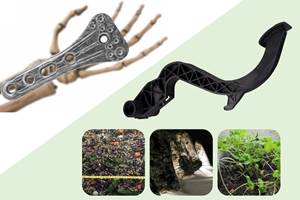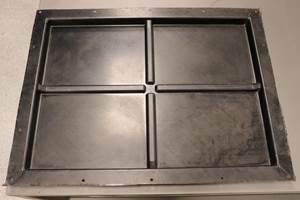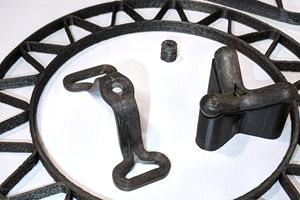Porous carbon fiber made from block copolymers may enable energy storage
Researchers at Virginia Tech have developed a process to synthesize porous carbon fibers with uniform size and spacing.
Researchers at Virginia Tech’s (Blacksburg, Va., U.S.) College of Science have used block copolymers to create carbon fibers with uniform porous structure with the aim of using the material for energy storage in automobiles and aircraft.
Guoliang Liu, an assistant professor in the Department of Chemistry, wanted to create carbon fibers designed to have micro-holes uniformly scattered throughout, similar to a sponge, that would store ions of energy. After tweaking a conventional method of chemically producing carbon fibers, Liu now has developed a process to synthesize porous carbon fibers for the first time with uniform size and spacing. He details this work in a recently published article in the journal Science Advances.
“Making porous carbon fibers is not easy,” Liu says. “People have tried this for decades. But the quality and the uniformity of the pores in the carbon fibers were not satisfactory. We designed, synthesized, and then processed these polymers in the lab, and then we made them into porous carbon fibers.”
Liu used a multistep chemical process using two polymers — polyacrylonitrile (PAN) and polyacrylonitrile-block-methyl methacrylate (PMMA).
PAN is well-known in the polymer chemistry field as a precursor compound to carbon fibers, and PMMA acts as a place-holding material that is later removed to create the pores.
In the past chemists have mixed PAN and PMMA separately into a solution, creating porous carbon fibers — but with differently sized and spaced pores. Energy storage can be maximized with greater surface area, which occurs with smaller, uniform pores.
Liu’s idea was to bond PAN and PMMA, creating a block copolymer. One half of the compound polymer is PAN, and the other half is PMMA, with the two halves covalently bonded in the middle.
“This is the first time we utilize block copolymers to make carbon fibers and the first time to use block copolymer-based porous carbon fibers in energy storage,” Liu says. “Often, we’re only thinking from the process point-of-view, but here we’re thinking from the materials design point-of-view.”
After synthesizing the block copolymer in the lab, the viscous solution undergoes three chemical processes to achieve porous carbon fibers.
The first step is electrospinning, a method that uses electric force to create fibrous strands and harden the solution into a paper-like material. Next, the polymer is put through an oxidation heating process. In this step, the PAN and PMMA naturally separated and self-assembled into the strands of PAN and uniformly scattered domains of PMMA.
In the final step, known as pyrolysis, the polymer is heated to an even higher temperature. This process solidifies PAN into carbon and removes PMMA, leaving behind interconnected mesopores and micropores throughout the fiber.
The researchers say the real breakthrough is the ability to use block copolymers to create uniform porous structures for energy storage possibilities.
“It opens the way we think about designing materials for energy storage,” Liu says. “Now we can also start to think about functionality. We not only use [carbon fibers] as a structural material but also a functional material.”
Other researchers working on the project include Zhengping Zhou, Liu’s former postdoctoral associate who now works as an assistant professor at North Dakota State University (Fargo, N.D., U.S.), Tianyu Liu, postdoctoral associate in the Liu Lab, and Assad Khan, a fifth-year doctoral student in the Department of Chemistry.
Related Content
Bioabsorbable and degradable glass fibers, compostable composite parts
ABM Composite offers sustainable options and up to a 60% reduction in carbon footprint for glass fiber-reinforced composites.
Read MoreUniFORM: High-quality, high-complex EV battery enclosures at low cycle times, low tooling costs
Stellantis subsidiary CpK Interior Products Inc. recently completed a design challenge to prove out its vacuum-assisted wet compression molding process for CFRP battery trays.
Read MoreInfinite Composites: Type V tanks for space, hydrogen, automotive and more
After a decade of proving its linerless, weight-saving composite tanks with NASA and more than 30 aerospace companies, this CryoSphere pioneer is scaling for growth in commercial space and sustainable transportation on Earth.
Read MoreHigh-performance, high-detail continuous 3D-printed carbon fiber parts
Since 2014, Mantis Composites has built its customer and R&D capabilities specifically toward design, printing and postprocessing of highly engineered aerospace and defense parts.
Read MoreRead Next
CW’s 2024 Top Shops survey offers new approach to benchmarking
Respondents that complete the survey by April 30, 2024, have the chance to be recognized as an honoree.
Read MoreComposites end markets: Energy (2024)
Composites are used widely in oil/gas, wind and other renewable energy applications. Despite market challenges, growth potential and innovation for composites continue.
Read MoreFrom the CW Archives: The tale of the thermoplastic cryotank
In 2006, guest columnist Bob Hartunian related the story of his efforts two decades prior, while at McDonnell Douglas, to develop a thermoplastic composite crytank for hydrogen storage. He learned a lot of lessons.
Read More
.png;width=70;height=70;mode=crop)

























